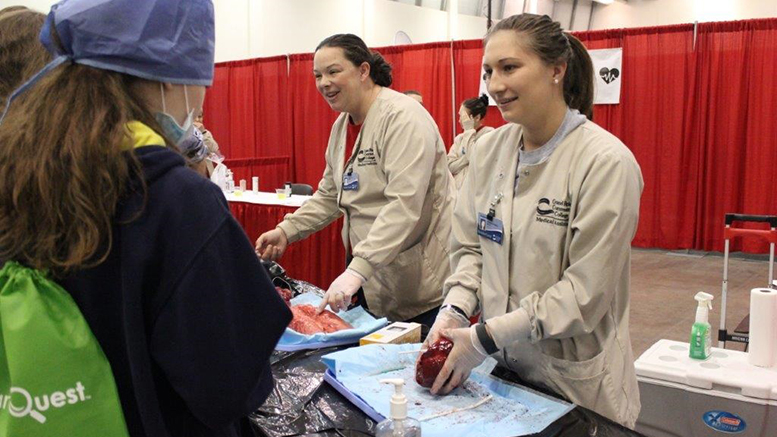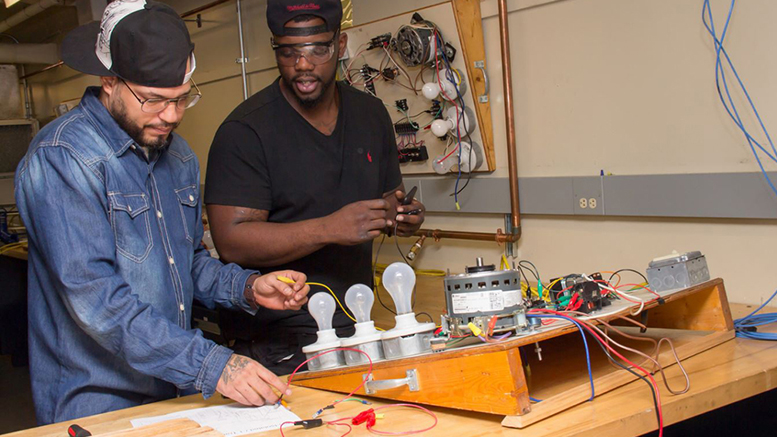When community colleges educate and train people for higher-paying jobs, they not only improve individuals’ lifestyles, but that investment benefits employers, taxpayers and local and state governments.
The Community College of Rhode Island’s (CCRI) partnership with General Dynamic Electric Boat, for example, creates a pipeline of talent and increased productivity for the company, while workers who move up to higher-paying career-track jobs generate more tax revenue for the state, says Julian Alssid, the college’s vice president of workforce development.
That partnership – formally called Pipeline to Manufacturing Careers in Ship Building – has so far led to more than 1,000 people placed in jobs at Electric Boat, says Nora Crowley of the Rhode Island Department of Labor and Training (DLT).
New hires have increased their wages by more than $18,000, Crowley says. Many of those hired are veterans, recent high school graduates, people in low-wage jobs or recipients of unemployment benefits.
The program provides training in maritime electrical, pipefitting and sheet-metal manufacturing as Electric Boat builds the next generation of submarines for the U.S. Navy. Demand is soaring, and the company plans to hire 10,000 people over the next few years, Alssid notes.
Current employees at Electric Boat, often in entry-level jobs, go for training at CCRI’s Westerly Education Center, which has a mock-up of half a submarine. During the six-week, non-credit training program, the company pays the workers’ wages and benefits, while Real Jobs Rhode Island, a program administered by DLT, covers the cost of instruction.
CCRI also has developed a customized course for apprentices in biomedical technicians and data scientists for CME, a medical equipment company, supported by funding from Real Jobs. Those who complete the three-year apprenticeship earn an associate degree, as well as a certificate.
“More than 3,400 Rhode Islanders are in jobs today after completing either new hire or incumbent worker training through Real Jobs Rhode Island, in such areas as advanced manufacturing, the marine trades and cybersecurity,” Crowley says.
Joining forces
SUNY Ulster, a community college in New York’s Hudson Valley, partners with the Council of Industry to learn about local manufacturers’ challenges, develop curricula and make sure its instructional programs are aligned with companies’ needs, says Christopher Marx, associate vice president for workforce, economic development and community partnerships.
The council helps the college apply for grants, create a manufacturing apprenticeship program and develop curricula, Marx says. In return, the council’s members get skilled workers, while incumbent workers gain access to training allowing them to advance to higher-paying jobs.
“It’s a long-term relationship, where there is trust, and both partners understand how each other operates and what their goals are,” he says. “We can bring them a project and know it will bring value to them.”
If a small company wants to hire two or three apprentices for a particular job, it’s hard to build a program around that, Marx says. But if 20 employers come together and each one will need five to 10 apprentices over the next five years, that’s something the college can address.
Local companies benefit by having access to “high-quality, inexpensive, customer-driven training,” says Harold King, executive vice president of the Council of Industry.
An adapting workforce
The region’s biggest employer had been IBM, but when IBM downsized, many smaller manufacturers that supplied parts to IBM had to reinvent themselves, King says. The current mix in the area includes lighting, clean tech, metal fabrication, food production and packaging companies. All of them, however, need workers with similar training in advanced manufacturing.
The council has participated in dozens of training programs with SUNY Ulster, King says, including soft skills, leadership and supervisor training and the Lean Six Sigma managerial approach, as well as training in technical skills, such as 3D drawing, brazing (a form of welding) and photovoltaic technology.
Students in an electromechanical technician program, which starts this fall, will earn credits toward a certificate and an associate degree. “We want to meet employers’ needs, but we also want this to be a pathway that builds to a higher level of attainment,” Marx says.
The council recently got approval from the New York State Department of Labor for a registered apprenticeship program to train people at manufacturing companies in geometric dimensioning and tolerancing (DG&T), a method of reading precise measurements in engineering. Instructors will come from SUNY Ulster, which has the latest 3D modeling equipment, and Westchester Community College.
“Without access to a community college, an organization like ours would have to take on the training role. It’s not something we’re good at,” King says. “We’re blessed to have great community colleges throughout the region. They totally understand what’s going on in manufacturing companies and what they need.”
Community benefits
Grand Rapids Community College (GRCC)’s relationships with West Michigan Works, other business groups and employers “has proven to be quite fruitful in ensuring the college provides training programs that lead to good jobs,” says Amy Mansfield, dean of workforce development.
In a recent example, when GRCC learned that local hospitals had a shortage of medical assistants, the college worked with West Michigan Works to create an apprenticeship program in medical assisting.

Amanda Hindsley (right), a student in a medical assistance program at Grand Rapids Community College, uses a pig heart to explain the cardiovascular system to high school students in the MiCareerQuest program. (Photo: GRCC)
Some, but not all, of GRCC’s medical assistance students serve as paid apprentices in the same local hospitals where they meet their clinical requirements. The college used a grant from the U.S. Labor Department’s apprenticeship initiative and West Michigan Works to help students cover their tuition on an individual basis.
Michigan Works selects students for the apprenticeship program through a battery of “talent and fit” tests to determine whether they have the right attitude to succeed, know what the career entails and have the skills for the job, Mansfield says.
A data sheet published last fall documenting the impacts of GRCC in Kent and Ottawa counties shows spending by students and alumni plus expenditures related to college operations added $447.7 million to the economy and supported 8,835 jobs.
According to GRCC, state and local taxpayers in Michigan paid $64.3 million to support the college in FY 2015-16. In return, they will receive a value of $240.3 million in added tax revenue from students’ higher lifetime earnings, and another $14.6 million in savings due to reduced demand for government-funded services. Looked at another way, taxpayers reap a return of $4 for every $1 in costs.
An investment pays off
In Pennsylvania, HACC, Central Pennsylvania’s Community College has developed long-term partnerships with many local companies and other organizations that have resulted in preparing students for better-paying jobs and thus enhancing the local tax base.
While the exact number of jobs created is hard to quantify, the college has trained 25,000 students in workforce programs this year.
HACC estimates that in 2013-14, payroll and operations spending by the college and spending by students and alumni generated $692 million in added income to the regional economy. For every dollar invested in the community college, an average of $7.10 in benefits will accrue to Pennsylvania over the course of the students’ careers.
On average, individuals with some college or an associate degree earn 26 percent more than high school graduates, says Victor Rodgers, associate provost for workforce development, and approximately 85 percent of HACC alumni stay in the region.
Alliances with employers are critical because “they allow the college to develop curriculum for companies together and solve their problems as a unit,” Rodgers says. “Before, companies were in separate silos.”
HACC has five cohorts of students in advanced manufacturing apprenticeships and earlier this year started an apprenticeship program in hospitality with High Hotels Ltd.
And when the Ames Reese manufacturing company was having trouble finding skilled workers and considered relocating, HACC stepped in to work with the firm and the Economic Development Company of Lancaster County to create an apprenticeship program in powdered metallurgy.
The first six students have completed the program, another cohort will start soon and the company is on track to add 50 employees in the upcoming year.
Additionally, HACC reaches out to community organizations, public housing agencies, and the region’s probation and parole systems to provide education to help people transition from poverty to self-supporting jobs.
“We meet them where they’re at and take them where they need to be,” Rodgers says.

